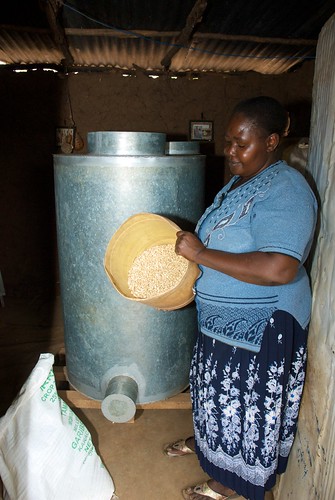 As traditional storage methods are proving less efficient, especially when faced with pests, a team of scientists from CIMMYT and the Kenya Agricultural Research Institute researched the effectiveness of hermetic systems in controlling maize storage pests in Kenya. To identify the most effective system, CIMMYT’s Hugo De Groote, Simon C. Kimenju, Fred Kanampiu, Tadele Tefera, and Jon Hellin, and KARI’s Paddy Likhayo, tested metal silos and super grain bags at three sites in Kenya and concluded that it is technically feasible to control storage insects without insecticides in Africa by using hermetic storage. However, several unanswered questions remain:
As traditional storage methods are proving less efficient, especially when faced with pests, a team of scientists from CIMMYT and the Kenya Agricultural Research Institute researched the effectiveness of hermetic systems in controlling maize storage pests in Kenya. To identify the most effective system, CIMMYT’s Hugo De Groote, Simon C. Kimenju, Fred Kanampiu, Tadele Tefera, and Jon Hellin, and KARI’s Paddy Likhayo, tested metal silos and super grain bags at three sites in Kenya and concluded that it is technically feasible to control storage insects without insecticides in Africa by using hermetic storage. However, several unanswered questions remain:
- While metal silos are very effective, they are also expensive. An economic analysis is necessary to determine the size at which silos become economical. Similarly, if super grain bags get perforated during the storage period, they can be used only once. If that is the case, what is their cost compared to other methods in the long run?
- The speed of oxygen depletion needs to be measured. Is oxygen depleting slowly in the super grain bags, thus allowing some insects to survive and perforate the bags from inside? Or did the larger grain borer found in the bags perforate the bag from outside? Answers to these questions are crucial for further steps in grain protection: if the insects survive slow oxygen depletion, it is necessary to find measures to speed up the process; if the insects perforate the bags from outside, additional protection is needed.
- Considering the pros (effective) and cons (costly) of metal silos, and the potential onetime- use-only quality of super grain bags, the authors considered the use of plastic rainwater tanks, which are very popular in Kenya and substantially cheaper than metal silos. Further research is needed to determine whether the larger grain borer would drill through the plastic.
 Nutrition, health and food security
Nutrition, health and food security